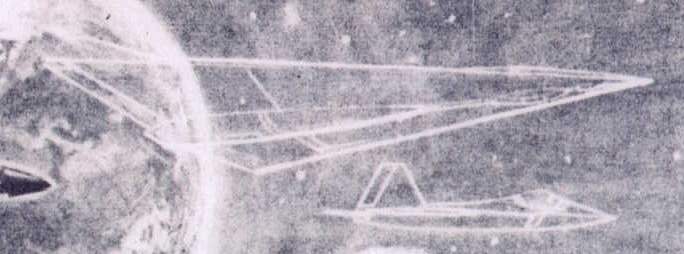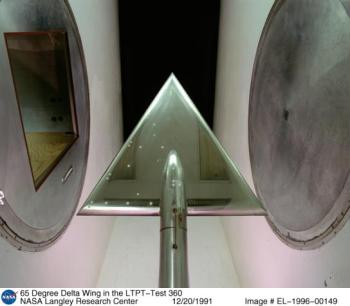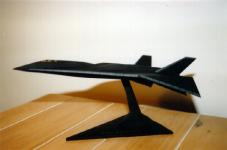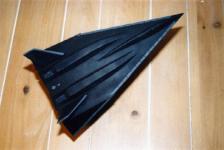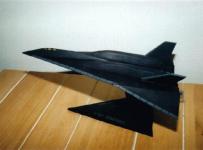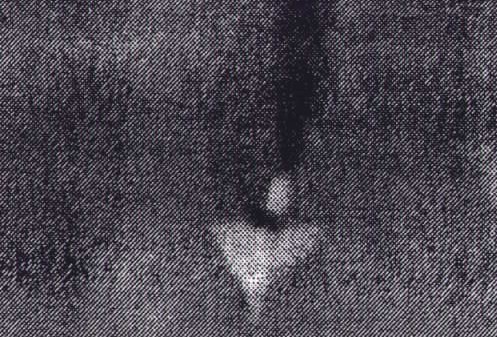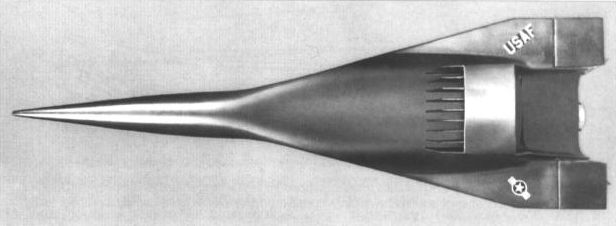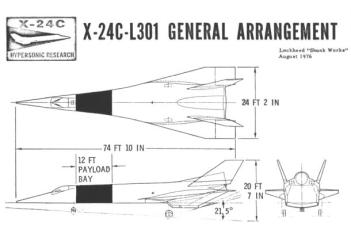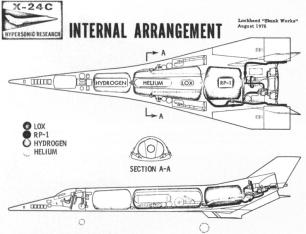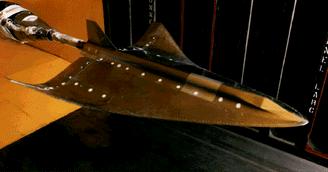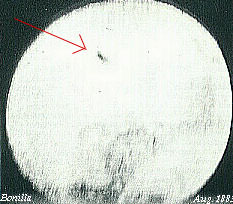May 2005 marks the 50th anniversary of flight test activities at Groom Lake, Nevada, best known to the public as DREAMLAND or Area 51. For half a century this remote desert outpost has served as a breeding ground for aircraft on the cutting edge of technology. It served as an important national asset during the Cold War and numerous conflicts throughout the globe. Dreamland continues to support the warfighter and keep America on the cutting edge of aerospace technology.
Humble Beginnings
The Central Intelligence Agency (CIA) established the Groom Lake test facility during Project AQUATONE, through which the Lockheed U-2 spy plane was developed. Capable of flying at high altitude while carrying sophisticated cameras and sensors, the U-2 was equipped with a single jet engine and long, tapered straight wings. For security reasons, CIA officials did not believe that the new airplane should be flown at Edwards Air Force Base, California. At the request of U-2 designer Clarence L. "Kelly" Johnson of the Lockheed Advanced Development Projects division (better known as the Skunk Works), project pilot Tony LeVier was dispatched to scout locations around the southwestern United States for a more remote test site.
Richard M. Bissell Jr., director of the AQUATONE program, reviewed dozens of potential test sites with his Air Force liaison, Col. Osmond J. "Ozzie" Ritland. None seemed to meet the program's stringent security requirements. Ritland, however, recalled "a little X-shaped field" in southern Nevada that he had flown over many times during his involvement with the nuclear weapons test program. The airstrip, called Nellis Auxiliary Field No.1, was located just off the eastern side of Groom Dry Lake, about 100 miles north of Las Vegas. It was also just outside the Atomic Energy Commission's (AEC) nuclear proving ground at Yucca Flat.
In April 1955, LeVier, Johnson, Bissell, and Ritland flew to Nevada on a two-day survey of the most promising lakebeds. After examining Groom Lake, it was obvious that this would be an ideal location for the test site, with its excellent flying weather and unparalleled remoteness. The abandoned airfield that Ritland remembered was overgrown and unusable, but the lakebed was excellent. Bissell later described the playa as "a perfect natural landing field...as smooth as a billiard table without anything being done to it."
Kelly Johnson originally opposed the choice of Groom Lake because it was farther from Burbank than he would have liked, and because of its proximity to the Nevada Proving Ground (later renamed Nevada Test Site). Johnson was understandably concerned about conducting a flight test program adjacent to an active nuclear test site. In fact, Groom Lake lay directly in the primary downwind path of radioactive fallout from atomic blasts.
Groom Lake was actually Johnson's second choice for the test location. He had already designed a base around his primary lakebed, dubbed Site I, which would have been a small, temporary camp with only the most rudimentary accommodations. Johnson estimated construction costs for such a facility at $200,000 to $225,000. Base requirements soon changed, however, calling for a permanent facility nearly 300% larger than Johnson's original design. Johnson estimated construction of a larger facility at Site I would cost $450,000. His estimate for building the same facility at Site II (Groom Lake) was $832,000. Johnson ultimately accepted Ritland's recommendation, largely because AEC restrictions would help shield the operation from public view. Bissell secured a presidential action adding the Groom Lake area to the AEC proving ground. Ritland wrote three memos to Air Force Headquarters, the AEC, and the Air Force Training Command that administered the gunnery range. Assistant Air Force Secretary for Research and Development Trevor Gardner signed the memos, this ensuring that range activities would not impinge on the new test site. Security for project AQUATONE was now assured.
During the last week of April 1955, Johnson met with CIA officials in Washington, D.C. and discussed progress on the base and the AQUATONE program. His proposal to name the base "Paradise Ranch" was accepted. It was an ironic choice that, he later admitted was "a dirty trick to lure workers to the program." The AQUATONE, officially designated U-2 became known as "The Angel from Paradise Ranch." The base itself was usually just called "The Ranch" by those who worked there.
On 4 May 1955, LeVier, Kammerer, and Johnson returned to Groom Lake in Lockheed's
Bonanza. Using a compass and surveying equipment, they defined a 5,000-foot, north-south runway on the southwest corner of the lakebed and designated a site for the camp.
On 18 May 1955, Seth R. Woodruff Jr., manager of the AEC Las Vegas Field Office, announced that he had "instructed the Reynolds Electrical and Engineering Co., Inc. [REECo] to begin preliminary work on a small, satellite Nevada Test Site installation." He noted that work was already underway at the location "a few miles northeast of Yucca Flat and within the Las Vegas Bombing and Gunnery Range." Woodruff said that the installation would include "a runway, dormitories, and a few other buildings for housing equipment." The facility was described as "essentially temporary." The press release was distributed to 18 media outlets in Nevada and Utah including a dozen newspapers, four radio stations, and two television stations. This, in effect, constituted Area 51's birth announcement.
Watertown Operations
LeVier and fellow Lockheed test pilot Bob Matye spent nearly a month removing surface debris from the playa. Levier also drew up a proposal to mark four three-mile-long runways on the lakebed at a cost of $450.00. Johnson, however, refused to approve the expense, citing a lack of funds. Drilling resulted in discovery of a limited water supply, but trouble with the well soon developed. Top priorities for the test site included hangars, a road, offices, living accommodations, and various support facilities. Since Lockheed did not have a license to build on the nuclear proving ground, they gave their drawings to a contractor who did: Silas Mason Construction Company. The Lockheed group hid their identity behind the fictional company name "CLJ", using Johnson's initials.
The fledgling base consisted of a single, paved 5,000-foot runway, three hangars, a control tower, and rudimentary accommodations for test personnel. The base's few amenities included a movie theatre and volleyball court. Additionally, there was a mess hall, several water wells, and fuel storage tanks. CIA, Air Force, and Lockheed personnel began arriving in July 1955 and Richard Newton of the CIA was assigned as base commander. The test site soon acquired a new name: Watertown. According to some accounts, the site was named after CIA director Allen Dulles' birthplace in Watertown, New York. It is still listed as a member of Alamo Township in Lincoln County.
The first U-2 was transported, disassembled, to Watertown in an Air Force C-124 cargo plane. It had no serial number and was designated Article 341. Tony LeVier made the unofficial first flight in the U-2 during a taxi test on 29 July. He piloted the first planned test flight on 4 August.
After completing Phase I (contractor) testing LeVier was replaced by Lockheed test pilots Bob Matye and Ray Goudey who expanded the airplane's altitude envelope to its operational limits. By November 1955, the test group also included Robert Sieker and Robert Schumacher.
On 17 November 1955, tragedy struck the AQUATONE project. An Air Force C-54M (44-9068) transporting personnel to the secret base crashed near the top of Mt. Charleston, about 20 miles west of Las Vegas. Nine civilians and five military personnel were killed. There were no survivors. After the accident, Lockheed assumed responsibility for transporting personnel to Watertown. A company-owned C-47 was used to ferry pilots, technicians, and special visitors to the test site.
By the beginning of 1956, four U-2 aircraft had been delivered to the Groom Lake test site. By the end of March the fleet consisted of nine aircraft, and six CIA pilots were undergoing flight training at the site. Four experienced instructor pilots trained three classes in ground school, followed by landing practice in a T-33 and, eventually, solo flights in the U-2. The second class underwent training at Groom between May and August 1956. It included Francis Gary Powers, who would later win dubious fame after being shot down and captured while flying a U-2 over the Soviet Union. The third training class was conducted in late 1956.
Several U-2 airplanes were lost in accidents including the prototype. Two CIA pilots were killed and one escaped without injury. Lockheed test pilot Robert Sieker perished in Article 341.
Atomic Blasts
Nuclear weapons testing at nearby Yucca Flat affected test and training activities at Watertown. During the first two years of the Watertown operation, the atomic proving ground had been quiet as all full-scale testing was taking place at Bikini and Eniwetok atolls in the Pacific Ocean. That changed in the summer of 1957 with Operation Plumbbob.
Because Groom Lake was downwind of the proving ground, Watertown personnel were required to evacuate the base prior to each detonation. The AEC, in turn, tried to ensure that expected fallout from any given shot would be limited so as to permit re-entry of personnel within three to four weeks. Evacuation plans included notification procedures, adequate security for classified areas, means to inform evacuees when they might return, and radiation monitoring. If a nuclear test was postponed, which occurred frequently, Watertown personnel were required to evacuate prior to each new shot date.
All personnel at the base were required to wear radiation badges to measure their exposure to fallout. AEC Radiological Safety (Rad-Safe) officers briefed Watertown personnel on nuclear testing activities and radiation safety, and presented a film called
Atomic Tests In Nevada. They also made arrangements for radiation monitors to visit the airbase whenever fallout was anticipated in the Watertown area.
Project 57, the first shot of the new series, took place on Watertown's doorstep. On 24 April 1957, the AEC conducted a safety experiment with an XW-25 warhead just five miles northwest of Groom Lake in Area 13. Only the bottom detonator of the device was fired, simulating an accident not involving a nuclear detonation. The test was designed to disperse a known quantity of plutonium over a defined area to develop effective monitoring and decontamination procedures.
Following several delays, full-scale nuclear detonations began on 28 May. Shot BOLTZMANN, a 12-kiloton blast, was fired from a 500-foot tower on northern Yucca Flat. After more delays, two minor blasts, FRANKLIN and LASSEN, were fired during the first week of June. These tests came near the intended end of Watertown's existence as an active installation.
The base had always been considered a temporary facility. As U-2 testing began to wind down and CIA pilot classes finished their training, Watertown became a virtual ghost town. By mid-June 1957, the U-2 test operation had moved to Edwards and operational U-2 aircraft were assigned to the 4028th Strategic Reconnaissance Squadron at Laughlin, Texas.
On 18 June 1957, a test code-named WILSON deposited fallout on Watertown. The AEC measured radiation exposure inside the evacuated buildings and vehicles at the base to study the effectiveness of various materials in shielding against fallout. In effect, Watertown served as a laboratory to determine the shielding qualities of typical building materials that might be found in any American town. WILSON was followed by the 37-kiloton PRISCILLA shot at Frenchman Flat on 24 June.
HOOD, the sixth nuclear shot of Plumbbob, was truly spectacular. It also caused substantial damage to the Groom Lake airbase. The device was lofted by balloon to a height of 1,500 feet over Yucca Flat, about 14 miles southwest of Watertown. On 5 July 1957, HOOD exploded with a yield of 74 kilotons. It was the most powerful airburst ever detonated within the continental United States. HOOD's shockwave shattered windows on two buildings at Watertown, and broke a ventilator panel on one of the dormitories. A maintenance building on the west side of the base and the supply warehouse west of the hangars suffered serious damage as their metal roll-up doors buckled.
Despite the end of U-2 operations and the near constant rain of fallout, security at the Watertown facility remained tight. On 28 July 1957, a civilian pilot was detained after making an emergency landing at Watertown airstrip. Edward K. Current Jr., an employee of Douglas Aircraft Company, had been on a cross-country training flight when he became lost, ran low on fuel, and decided to land at Groom Lake. He was held overnight and questioned before being released.
On 20 June 1958, 38,400 acres of land encompassing the Watertown base was officially withdrawn from public access under Public Land Order 1662. This rectangular addition to the Nevada Test Site was designated Area 51. Shortly after this, the National Aeronautics and Space Administration (NASA) secured permission to designate Groom Lake as a contingency landing site for the X-15 rocket plane. It was, however, never needed for this purpose. For two years following the departure of the U-2 fleet from Watertown, the base was fairly quiet.
New Lease on Life
Dramatic changes came to Area 51 with the advent of Project OXCART, through which Lockheed's proposed successor to the U-2 was developed. The OXCART aircraft was a sleek, powerful looking aircraft with a long tapered forward fuselage with blended chines. A rounded delta wing supported two turbo-ramjet engines capable of boosting the aircraft to Mach 3.2 at altitudes in excess of 90,000 feet. Twin, inwardly canted tails and a sawtooth internal structure in the wing edges contributed to a low overall RCS. The airframe was constructed mostly of titanium, with asbestos-fiberglass and phenyl silane composites in the leading and trailing edges, chines, and tails for RCS reduction. The final designation for the OXCART aircraft was A-12, with the "A" standing for "Archangel."
The Skunk Works team in Burbank built a full-scale mock-up of the A-12 during the spring of 1959 for RCS tests to be performed by Edgerton, Germeshausen & Grier (EG&G) of Las Vegas. On 10 September, EG&G agreed to move its radar test facility from Indian Springs, Nevada, to Groom Lake for security reasons. A special pylon was constructed on a paved loop road on the west side of the lakebed. The A-12 mock-up was moved from Burbank to the test site on a specially designed trailer truck. By 18 November, the model was in place. It took 18 months of testing and adjustment before the A-12 achieved a satisfactory RCS.
Naturally, a secret location was needed for testing the triple-sonic A-12. Ten U.S. Air Force bases programmed for closure were considered, but none provided adequate security, and annual operating costs were prohibitive for most. Groom Lake was selected although it lacked personnel accommodations, fuel storage, and an adequate runway. Lockheed planners estimated cost requirements for monthly fuel consumption, hangars, maintenance facilities, housing, and runway specifications. The CIA then produced a plan for construction and engineering. A CIA cover story stated that the facilities were being prepared for radar studies to be conducted by an engineering firm with USAF support. Construction at the site, referred to as Project 51, was performed by Reynolds Electrical and Engineering Company (REECo).
Base construction began on 1 September 1960 and continued on a double-shift schedule until 1 June 1964. Workers were ferried in from Burbank and Las Vegas on C-54 aircraft. Since the existing 5,000-foot runway was incapable of supporting the weight of the A-12, a new airstrip (runway 14/32) was constructed between 7 September and 15 November 1960. The A-12 required a runway at least 8,500 feet long. About 25,000 cubic yards of concrete were poured to make the airstrip. A 10,000-foot asphalt extension, for emergency use, cut diagonally across the southwest corner of the lakebed. An Archimedes curve approximately two miles across was marked on the dry lake so that an A-12 pilot approaching the end of the overrun could abort to the playa instead of plunging the aircraft into the sagebrush. Area 51 pilots called it "The Hook." For crosswind landings two unpaved airstrips (runways 9/27 and 03/21) were marked on the dry lakebed.
Kelly Johnson had been reluctant to construct a standard Air Force runway, with expansion joints every 25-feet, because he feared the joints would set up undesirable vibrations in the OXCART aircraft. At his suggestion, the 150-foot-wide runway was constructed in segments, each made up of six 25-foot-wide longitudinal sections. The sections were 150 feet long and staggered. This layout put most of the expansion joints parallel to the direction of aircraft roll, and reduced the frequency of the joints.
Essential facilities were completed by August 1961. Three surplus U.S. Navy hangars were obtained, dismantled, and erected on the base's north side. They were designated as Hangar 4, 5, and 6. A fourth, Hangar 7, was built new. More than 130 U.S. Navy surplus Babbitt duplex housing units were transported to the base and made ready for occupancy. The original U-2 hangars were converted to maintenance and machine shops. Facilities in the main cantonment area included workshops and buildings for storage and administration, a commissary, control tower, fire station, and housing.
It was determined that 500,000 gallons of JP-7 fuel would be needed monthly to support the OXCART program. By early 1962 a fuel farm, including seven tanks 1,320,000-gallon capacity was complete. Older buildings were repaired, and additional facilities were constructed as necessary. A reservoir pond, surrounded by trees, served as a recreational area one mile north of the base. Other recreational facilities included a gymnasium, movie theatre, and a baseball diamond. On 15 November 1961, USAF Col. Robert J. Holbury was named commander of the secret base, with the CIA's Werner Weiss as his deputy. The base was still a CIA facility, and would remain so for another 18 years.
OXCART and the Roadrunners
Support aircraft began arriving in the spring of 1962. These included eight McDonnell F-101B/F
Voodoos for training and chase, a Lockheed C-130
Hercules for cargo transport, U-8A for administrative use, Cessna 180 for liaison use, and Kaman HH-43 helicopter for search and rescue. A Lockheed F-104A/G (56-0801) was supplied as a chase plane during the OXCART flight test period.
In January 1962, the Federal Aviation Administration (FAA) expanded the restricted airspace in the vicinity of Groom Lake. The lakebed became the center of a 600-square-mile addition to restricted area R-4808N. Restricted continuously at all altitudes, the airspace occupies the center of the Nellis Air Force Range.
The prototype A-12 (60-6924) made its unofficial first flight on 25 April 1962 with Louis W. Schalk at the controls. He flew the aircraft less than two miles at an altitude of about 20 feet. The following day, Schalk made a 40-minute flight. An official "first flight" on 30 April was witnessed by a number of dignitaries including Richard Bissell (even though he had resigned from the CIA in February) and FAA chief Najeeb Halaby.
OXCART pilot Jack Weeks nicknamed the A-12
Cygnus after the constellation of the swan. Initially, all 15 A-12 aircraft were based at Groom Lake and operated by the 1129th Special Activities Squadron
Roadrunners, commanded by Col. Hugh "Slip" Slater. A-12 test aircraft (60-6924, 60-6925, 60-6928), and the TA-12 trainer (60-6927) were housed in hangars at the north end of the flightline. Operational aircraft were kept in Hangars 9 through 16 at the southern end of the base. Security was paramount. Even the existence of the A-12 was a closely guarded secret.
With the assistance of the CIA, the U.S. Air Force entered into an agreement with Lockheed to build three prototypes of an interceptor version of the A-12 under project KEDLOCK. Known as the AF-12 (later changed to YF-12A), the design included a second crew position, air-to-air missiles, and fire-control radar in the nose. The first YF-12A (60-6934) made its maiden flight on 7 August 1963 with James Eastham at the controls. After President Lyndon B. Johnson announced the existence of the aircraft in March 1964, the YF-12A test was program moved to Edwards.
Dreamland
Construction of the Area 51 facility was completed in 1965. The site population had grown to 1,835, and contractors were working three shifts a day. Lockheed-owned
Constellation and C-47 aircraft made several flights a day ferrying personnel from Burbank and Las Vegas to Groom Lake. Hughes and Honeywell had facilities on site, and Pratt & Whitney operated an engine test stand. Perkin-Elmer set up a special building in which to work on the equipment bays in the nose of the A-12.
During the course of the OXCART program, Kelly Johnson developed an unmanned reconnaissance drone that could be launched from a modified version of the A-12. Codenamed TAGBOARD, the drone was a ramjet-powered vehicle capable of reaching 90,000 feet at Mach 3.3. Two OXCART-type aircraft (60-6940 and 60-6941) were purpose-built to launch TAGBOARD. Each was equipped with a rear seat for a Launch Systems Operator (LSO), and a dorsal launch pylon. The TAGBOARD was designated D-21 and the launch aircraft were given the unusual designation M-21. The first D-21 was launched 5 March 1966.
Unfortunately, the second M-21 was lost during the fourth TAGBOARD launch, when the drone collided with the launch aircraft. Pilot Bill Park ejected safely and was rescued 150 miles off Point Mugu, California. His LSO Ray Torick ejected but drowned before he could be rescued. The tragic loss of an aircraft and crewmember ended the use of OXCART as a launch aircraft, but it did not spell the end of TAGBOARD.
In 1967, the D-21 received a new lease on life. Under the SENIOR BOWL program, the drone was reconfigured for launch from a B-52 and redesignated D-21B. It was reconfigured for launch from inboard wing pylons and propelled to ramjet-ignition speed by a rocket booster. Two B-52H aircraft (60-0036 and 61-0021) from the 4200th Support Squadron at Beale Air Force Base, California, were sent to Groom Lake for the test program. The unofficial first flight occurred on 28 September 1967, when a D-21B was accidentally dropped due to a mechanical failure. The first actual launch attempt took place 6 November. Flight-testing continued through July 1969. The program was terminated in 1971 after only four operational flights.
At some point during the late 1960s, Area 51 gained a new nickname: DREAMLAND. This purportedly was derived from
DREAM-LAND, a poem by Edgar Allan Poe. It describes lakes that "endlessly outspread" with waters "lone and dead." More to the point, Poe admonishes that "the traveler, traveling through it, may not-dare not openly view it; Never its mysteries are exposed, to the weak human eye unclosed." Coincidence or not, it is certainly an apt description of Area 51.
Several A-12 airplanes were deployed from Area 51 to Kadena, Japan, for Operation Black Shield reconnaissance flights over Southeast Asia in 1967. One of the airplanes was lost during a training mission and the pilot presumed killed. Four A-12s had been lost in accidents at or near Area 51, but only one of these was fatal. The surviving airframes were retired in June 1968 and placed in storage at a Lockheed facility in Palmdale. The A-12 remained unknown to the public for 12 more years while the YF-12A and later SR-71 became some of the most famous airplanes in the world.
Red Hats
Beginning in the late 1960s, and for several decades, DREAMLAND played host to a motley assortment of Soviet-built aircraft. The first such program, in 1968, involved technical and tactical evaluations of a MiG-21F-13 that the Israeli Defense Forces had acquired from an Iraqi defector. Called HAVE DOUGHNUT, the project was a joint effort of the U.S. Air Force Systems Command, Tactical Air Command, and the U.S. Navy's Air Test and Evaluation Squadron Four (VX-4). The MiG-21 was flown against nearly all U.S. combat aircraft types, allowing Air Force and Navy pilots to develop improved tactics for combating Eastern bloc aircraft.
A similar evaluation program in 1969, called HAVE DRILL/HAVE FERRY, involved two Syrian MiG-17F fighters. As in the earlier program, a small group of Air Force and Navy pilots conducted mock dogfights with the MiG-17. Selected instructors from the Navy's Top Gun school at NAS Miramar, California, were chosen to fly against the MiGs for familiarization purposes.
Testing of foreign technology aircraft continued and expanded throughout the 1970s and 1980s. Additional MiG-17, MiG-21, MiG-23, Su-7B, Su-22 and other aircraft underwent intensive evaluations. The 6513th Test Squadron
Red Hats from the Air Force Flight Test Center (AFFTC) at Edwards conducted technical evaluation sorties. The 4477th Test and Evaluation Squadron
Red Eagles, headquartered at Nellis Air Force Base, Nevada, performed tactical evaluations. In April 1984 Lt. Gen. Robert M. Bond, Vice Commander of Air Force Systems Command, lost his life in the crash of a MiG-23 during an orientation flight.
Area 51 also hosted another foreign materiel evaluation program called HAVE GLIB. This involved testing Soviet tracking and missile control radar systems. A complex of actual and replica Soviet-type threat systems began to grow around "Slater Lake" (the pond, which had been named after the former
Roadrunners commander), a mile northwest of the main base. They were arranged to simulate a Soviet-style air defense complex.
The Air Force began funding improvements to Area 51 in 1977 under project SCORE EVENT. In 1979, the CIA transferred control of the test site to the AFFTC at Edwards. It was now a remote operating location of the Center, and was designated Detachment 3, AFFTC. Sam Mitchell, the last CIA commander of Area 51, relinquished command to Lt. Col. Larry D. McClain.
Pioneers of Stealth
In November 1977, a C-5 arrived at Groom Lake carrying the Lockheed HAVE BLUE prototype. HAVE BLUE was the first airplane designed to be virtually invisible to radar. The single-seat jet looked like a faceted arrowhead with two inwardly canted tail fins. Its boxy, angular fuselage and wings contributed to its low RCS. It was eventually covered with radar absorbent material (RAM). Such shaping and material treatments rendered the airplane "low observable" or "stealthy."
The first HAVE BLUE vehicle, Article 1001, was flown to demonstrate handling characteristics. The second was scheduled to carry out tests of the low observable (L.O.) characteristics. After arriving at the test site, Article 1001 underwent a few weeks of flight control, engine, and taxi tests. Every time HAVE BLUE was rolled out of its hangar, uncleared personnel at the base were sequestered to prevent them from seeing the aircraft.
HAVE BLUE first flew on 1 December 1977 with Lockheed test pilot Bill Park at the controls. Skunkworks chief Ben Rich, his predecessor "Kelly" Johnson, and Ken Perko of the Advanced Research Projects Agency were on hand to witness the event. The flight was also monitored by the White House Situation Room and Tactical Air Command Headquarters at Langley Air Force Base, Virginia. Article 1001 completed 36 flights before being lost in a non-fatal accident.
Article 1002, the low observables technology demonstrator, made its first flight on 20 July 1978 piloted by Lt. Col. Norman "Ken" Dyson. It made 52 flights against sophisticated U.S. and Soviet ground-based radars, and the E-3 Airborne Warning And Control System (AWACS). Article 1002 was lost on 11 July 1979 due to an engine fire. At the time of the accident only one final test flight had been scheduled for the HAVE BLUE program.
In October 1978, Lockheed conducted the first test of its stealth cruise missile, code named SENIOR PROM. Six prototypes were built. They somewhat resembled a subscale, unmanned version of the HAVE BLUE, but with outwardly-canted tails, narrow wings, and a single jet intake located where the cockpit would have been. The demonstrator models were launched from a DC-130. Thirteen test flights were made, and all six vehicles recovered. The recovery method involved deploying a ballistic parachute and inflating a ventral landing bag. Although the SENIOR PROM tests were successful, the contract for production of a stealthy Advanced Cruise Missile (ACM) went to the less expensive General Dynamics AGM-129A. SENIOR PROM was cancelled in 1981.
On 17 January 1981 the Lockheed test team at Groom Lake accepted delivery of the first SENIOR TREND Full Scale Development (FSD) prototype, Ship 780, designated YF-117A. Like the HAVE BLUE, it too resembled a faceted arrowhead, except that the tails were canted outward in a "V" shape. Ship 780 first flew on 18 June 1981 with Lockheed test pilot Hal Farley at the controls.
By early 1982, four more YF-117A airplanes were operating out of the southern end of the base, known as the "Southend" or "Baja Groom Lake." After finding a large scorpion in their offices, the test team adopted it as their mascot and dubbed themselves the "Baja Scorpions."
As the Baja Scorpions tested the FSD airframes, production F-117A aircraft were shipped to DREAMLAND for acceptance testing. Following functional check flights and L.O. verification, the operational airplanes were deployed to the 4450th Tactical Group at Tonopah Test Range, in the northwest corner of the Nellis Range.
While HAVE BLUE and SENIOR TREND were being put through their paces in Nevada, the Air Force, Defense Advanced Research Projects Agency, and Northrop Aircraft Corporation teamed up to develop a new aircraft. Code-named TACIT BLUE, it was originally designed as a technology demonstrator for a low-observable surveillance aircraft with a low-probability-of-intercept radar, and other sensors, that could operate close to the front line of battle with a high degree of survivability. Although plans for a stealthy surveillance aircraft were abandoned, TACIT BLUE provided important data that aided in the development of several other weapons systems. These included the B-2 advanced technology bomber, the AGM-137 Tri-Service Standoff Attack Missile (TSSAM), and the PAVE MOVER program (which led to the development of the E-8 Joint-STARS aircraft). TACIT BLUE was the first aircraft to demonstrate a low RCS using curved surfaces.
Only one complete TACIT BLUE prototype was constructed. A second, partially completed, shell was built as a back up. The aircraft featured a curved upper surface with a flush dorsal intake. Twin turbofan engines gave it a cruising speed of about 260 miles per hour. TACIT BLUE sported tapered straight wings and two square fins in a widely spaced V-tail configuration. Flat, squared "platypus bills" on the nose and tail gave it a nearly rectangular planform. From the side, TACIT BLUE resembled a whale, complete with a blowhole. In fact, the TACIT BLUE team members nicknamed it "
The Whale," and referred to themselves as "Whalers."
The nearly complete TACIT BLUE aircraft was trucked to the test site in several large crates for final assembly in Hangar 8. Northrop test pilot Richard G. Thomas, made the first flight of TACIT BLUE on 5 February 1982. TACIT BLUE made a total of 135 sorties, flown by a team of one contractor and four Air Force pilots. Thomas made 70 of the flights, including the 100th sortie on 27 April 1984. The final flight took place on 14 February 1985. Following a highly successful test program, the one-of-a-kind aircraft was stored in the Area 51 "boneyard." In April 1996, it was declassified and delivered to the U.S. Air Force Museum in Dayton, Ohio for permanent display.
Expansion and Acquisition
Because Groom Lake's site population had grown substantially, the C-54 aircraft had become inadequate to transport all the personnel. The Air Force contracted EG&G Special Projects, McCarran Operations, in Las Vegas to transport commuters to DREAMLAND in a fleet of six Boeing 737-200s. These flights, using the call sign JANET, carried personnel and freight daily from Las Vegas, Palmdale, and Burbank to Groom Lake, and later Tonopah Test Range.
Beginning in 1979, the Air Force began actively discouraging, and at times preventing, any public or private entry to the Groom Mountains, north of Groom Lake. Air Force personnel claimed it was "in the interest of public safety and national defense." This was about the time the Air Force took control of the Groom Lake facility from the CIA. Not only were hunters and hikers excluded from the mountains north of Groom Lake, but also citizens with mining claims in the area. In 1981, the Air Force discreetly requested that 89,600 acres of land encompassing the range be legally withdrawn from public use. The process of approving this request took several years. It also resulted in a battle between the government, citizens, and various special interest groups (such as the Sierra Club). In the end, the government won.
By March 1984, government security personnel prohibited travel and controlled access along the Groom Lake road northeast of the lakebed. In August, the Groom Mountains withdrawal was approved subject to an environmental impact statement (EIS) and public hearings. Congress officially authorized the withdrawal in 1987, and the following year President Ronald Reagan signed legislation making the Groom Mountains part of the Nellis Air Force Range until 2003. None of the documentation (EIS, archeological surveys, etc.) mentioned Area 51 or the Groom Lake test facility.
As public access became increasingly restricted, facilities in the DREAMLAND complex increased dramatically in number and size. During the mid-1980s new dormitories were constructed to replace the Babbitt housing. Several large water tanks were added to supply the base. Hangar 18 was built near the south ramp. Four "Rubber Duck" temporary aircraft shelters were erected near the Southend for use by TAC personnel during F-117A acceptance tests. Many new facilities were built and, by the end of the decade the "Rubber Duck" shelters were replaced with metal hangars (Hangars 20 through 23). Recreational facilities expanded to include the softball diamond and movie theatre, as well as a swimming pool and tennis courts. The latter are located adjacent to
Sam's Place, the local saloon and recreation center.
Runway 14/32 was extended 4,600 feet further southeast of the lakebed because the north end was subject to flooding during the rainy season. The runway now consisted of a 13,530-foot strip of concrete, 150 feet wide. The 10,000-foot hard asphalt extension and lakebed abort curve remained, but fell into disuse. The cost of maintaining the concrete runway became increasingly prohibitive. AFFTC leadership determined that the most cost effective solution would be to keep the southern half of the airstrip open until a new, parallel paved strip (runway 14L/32R) could be completed. The new concrete strip was constructed in 1991. It does not extend out onto the lakebed, but a lead-in line to the abort curve was marked on the lakebed. The northern half of the original runway (14R/32L) was closed, reducing its length to about 10,000 feet. It was finally closed along its entire length. In 2001 the South Delta Taxiway was marked as runway 12/30. It is approximately 5,420-feet-long and 150-feet-wide, with convenient access to the Southend ramp. A new central taxiway was constructed in 2003 to support runway 14L/32R.
The Groom Lake base received some unwanted publicity in 1994 when a number of former workers from the site sued the government. They claimed their health had been damaged by inhaling toxic fumes from the burning of waste materials in open trenches near the main base. For four months after the suit was filed, the government determinedly denied the existence of the base itself. Finally, however, it was forced to acknowledge that there was "an operating location at Groom Lake," but refused to provide a legal name for it citing "national security" concerns.
Air Force secretary Sheila Widnall declared that the facility "has no actual operating name per se." This was partially true. Since the Air Force had taken control of the facility in 1979 they had not used the name "Area 51," but instead simply referred to the operating location as DET 3, AFFTC,. Attorney Jonathan Turley tried on behalf of the plaintiffs to get the government to provide a legal name for the site, but was stymied at every turn.
The lawsuit forced the government to formally acknowledge the Groom Lake facility in order to keep its secrets. On 29 September 1995, President Bill Clinton signed Presidential Determination No. 95-45, which stated in part: "I find that it is in the paramount interest of the United States to exempt the United States Air Force's operating location near Groom Lake, Nevada from any applicable requirement for the disclosure to unauthorized persons of classified information concerning that operating location."
Space Invaders
Area 51's secret nature has bred rumor and speculation among fringe groups that believe the U.S. government is hiding captured extraterrestrial spacecraft, or even aliens (dead or alive) at the site. Such stories have been circulating since at least the late 1970s. Starting in 1989, groups of UFO believers began to camp out near the Nellis Range boundaries near Groom Lake to watch for "flying saucers."
As the news media caught wind of these "saucer base expeditions," print and television publicity was met with stony silence and terse denials from Air Force officials. This further fueled public speculation, spawned new rumors, and attracted still more publicity. Camera crews from around the world descended on the remote and forbidding Nevada desert. Local entrepreneurs capitalized on the situation by selling all manner of Area 51 souvenirs, videos, and visitor's guides.
The DET 3 security force, comprised of Air Force and civilian contractor personnel, worked overtime to intercept the "alien" invaders. A few civilians discovered that some nearby hilltops with a bird's-eye view of the secret base had been overlooked in the government's Groom Range land grab. Word quickly spread. Tourists sometimes camped on the hilltops 24 hours a day for days at a time. Flight test operations and even ground activities had to be postponed or cancelled. In April 1995, the Air Force seized 5,000 more acres of public land to prevent civilians from viewing the base.
Out of the Black, Into the Blue
While many current and historic programs at Dreamland remain classified, some information has been released to the public. Formal announcements, published technical papers, and official personnel biographies often reveal details of previously "black" projects. In the absence of official information, rumors abound.
The Northrop B-2
Spirit Advanced Technology Bomber has frequently been seen over DREAMLAND. Prototypes from the B-2 Combined Test Force at Edwards AFB and operational aircraft from a detachment of the 509th Bomb Wing at Whiteman AFB, Missouri have flown against Soviet-type radar systems and the Dynamic Coherent Measurement System (DYCOMS). Known on-site as Project 100, this airborne RCS range has been used to measure the L.O. characteristics of all U.S. stealth aircraft from the F-117A to the F/A-22A.
Project HAVE GLASS was undertaken in 1982 to significantly reduce the RCS of the General Dynamics F-16
Fighting Falcon. A series of modifications included RAM coatings and fillings, reflective materials, and component shape changes. The results were verified using the DYCOMS.
In 1983 AeroVironment received CIA sponsorship to build a proof-of-concept high-altitude, solar-powered, radio-controlled UAV called HALSOL. It was essentially a rectangular flying wing made from lightweight materials. Initial test flights were powered by eight electric motors using silver-zinc batteries. HALSOL made nine test flights.
Maj. Frank T. Birk piloted the first flight of a "classified technology advanced demonstration prototype" at Groom Lake in 1983. He made the first flight and two additional flights for handling qualities evaluation and performance envelope expansion testing.
On 2 October 1992, the 413th Flight Test Squadron was activated at Edwards to provide test and evaluation capability for electronic warfare (EW) systems. This change supported a consolidation of all Air Force electronic combat assets in the western United States. The mission of the 413th included planning, providing for, and organizing worldwide ground and flight tests of EW systems and equipment. A detachment of the 413th FLTS conducted EW testing at Groom Lake. In May 2004 the 413th Flight Test Squadron was inactivated as part of another consolidation and realignment of EW assets that were then absorbed by the EW Directorate at Edwards.
In the early 1990s Dennis F. "Bones" Sager was handpicked to lead a "classified prototype aircraft" called the YF-113G from design to first flight. As a fighter pilot and experimental test pilot, Sager accumulated over 2,900 flight hours in 54 aircraft types including Soviet fighters at Groom Lake. He was first Air Force pilot to fly the YF-113G.
On October 18, 2002, Boeing uncloaked its secret Bird of Prey technology demonstrator that was used to pioneer revolutionary advances in low-observables, aircraft design, and rapid prototyping. The project, initiated in 1992, remained highly classified even after its conclusion in 1999. A Boeing spokesman announced that it had been declassified "because the technologies and capabilities developed [during the program] have become industry standards, and it is no longer necessary to conceal the aircraft's existence." Phantom Works chief test pilot Rudy Haug piloted the maiden flight of Bird of Prey in the fall of 1996. After McDonnell Douglas merged with Boeing on August 1, 1997, The Boeing Company continued to fund the project. Three pilots flew only 38 missions between 1996and 1999.
Doug Benjamin, assigned to the Special Projects Flight Test Squadron, was the only Air Force pilot to fly the Bird of Prey. He flew 21 test flights including envelope expansion, mission utility, and tactical applications sorties. Following Benjamin's retirement from the military service in 2000, it was revealed that he had flown three other classified aircraft.
Joseph A. "Broadway Joe" Lanni flew first flights of two classified prototypes during the 1990s. One of them was designated YF-24. Between 1992 and 1997 he flew hundreds of sorties in 10 different classified aircraft to evaluate performance, flying qualities, avionics, and military utility. His assignment to the "Red Hats" during this time suggests that many of these aircraft were foreign types but some may have been entirely new aircraft.
There have also been reports of Advanced Concept Technology Demonstrator (ACTD) projects undergoing flight tests at Groom Lake. Other projects at the site may include stealth helicopters, weapons development, unmanned aerial vehicles, and avionics testing.
Silent Service
For half a century, the Groom Lake test site has been a valuable asset for the development of aerospace vehicles and weapon systems. There, workers toil in relative isolation and inhospitable conditions to prove revolutionary technologies and enhance the readiness of today's warfighter and support national requirements.
Most non-permanent base residents commute to Groom Lake an Mondays, and often stay at the base until Thursday or Friday. Because of the sensitive nature of their work, they can't share their accomplishments with friends and family. Former base commander Col. Larry McClain summarized this burden of silence: "For it is the lot of some men to be assigned duties about which they may not speak. Such work is not for every man. But those who accept the burdens implicit in this silent labor realize a camaraderie and sense of value known to few. These memories cannot be stolen. They will last always, untarnished, ever better."
In his poem, "A Tribute to All the Whalers," J. E. Coleman describes DREAMLAND in this way:
AMERICA'S STRENGTH THROUGH TECHNOLOGY
IS WHAT IS KEEPING FREE MEN FREE
SO IF YOU EVER HEAR ABOUT THIS PLACE
PLEASE HOPE IT EXISTS IN TIME AND SPACE
FOR WHAT THEY DO THERE CAN'T BE TOLD
BUT FREEDOM'S LIGHT THEY THERE UPHOLD Many projects tested at Groom Lake over the last five decades are still classified. The full story of this unique national asset may never be known. Nevertheless, DREAMLAND is beginning to yield its secrets at last.




